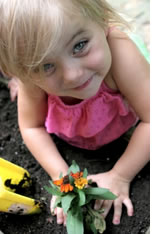
 |
Going Green How to Set Up a Garden in Your Service It's never too early to introduce children to the joy of gardening and child care centres are an excellent place to plant those early seeds of interest. According to US website kidsgardening.org gardening programs in child care centres and preschools are beneficial because:
|
- gardening lessons emphasise direct experience and sensory learning and provide opportunities for children to both ask and answer questions.
If you are interested in establishing a garden in your service follow the suggestions below to ensure success, no matter how un-green fingered you are!
- Start SMALL! It's okay to plan big, but start small. A large garden can exhaust both you and the kids. Let them get excited about the joy and fun of a bountiful, small garden, and then expand as your confidence and experience increases.
- Involve the kids in all stages. Engage them in as many of the planning steps as is reasonable based on the age of the children, including design and choosing plant material. This helps create a sense of ownership and enriches the learning experience.
- Spend time preparing the soil. Ask any farmer or gardener — they'll tell you the most important step in the planting process is preparing the soil. Healthy, well-drained soil rich in organic matter produces healthy plants that are more resistant to pest and disease problems. You will recoup all the time and money spent preparing the soil through decrease in maintenance. If you are using containers, obtain high quality, well-drained potting mix (and make sure containers have drainage holes).
- Prepare for the elements. Make sure each child is prepared with sunscreen, a hat, and plenty of water. You may wish to provide child-sized garden gloves for digging in soil.
- Teach kids proper garden behavior. Before going to the garden, make sure each child knows how to care for and work with the necessary garden tools. Establish a few basic guidelines such as "No one is to eat anything out of the garden without permission." Take time to demonstrate all garden techniques before asking kids to get started.
- Work in small groups and recruit additional adult garden helpers if needed. Kids want to dig, rake, water, and harvest. Working with kids in small groups of two or three helps you engage each child and make sure they are actively involved at all times.
- Avoid garden clutter. Tools, empty pots, and piles of discarded plants are not only unsightly, they're a safety hazard. After each work day, put away tools and place weeds and spent plant matter in a compost bin or trash can. It helps to have your garden storage close by and accessible.
- Use cultural and mechanical pest control. Although pesticides are safe when properly applied and all instructions are followed, cultural and mechanical pest control methods should be used in children's gardens. This reduces the amount of oversight and instruction needed for a safe gardening experience.
- Obtain child-sized garden tools. Adult tools are too heavy and bulky for young children. Smaller gardening tools designed just for kids are available at many garden centers. As long as the soil has been properly prepared, most garden work can be completed with a small trowel.
- Plant for immediate and delayed gratification. Watching new plants sprout from seeds is like magic for young kids, but slow germination rates can try their patience, so plant both seeds and potted plants
- Avoid poisonous plants. Although every child needs to learn that some plants are not good to eat or touch, it is best to avoid poisonous plants and those with irritating characteristics such as thorns.
- Add whimsical elements to engage the imagination. Although the plants on their own will inspire creativity, adding in elements such as a seating area, bean tepee, sunflower house, wind chimes, bird feeder, stepping stones, and so on further stimulate wonder and creative garden play.
- Let kids direct explorations. What captures your attention may not attract the children's, so follow their lead. Help them investigate things that interest them, and share in their excitement.
- Don't stress about the garden's appearance. In a child's garden, plants will get stepped on, leaves will be picked, and weeds will grow, but the kids will still think it is the most beautiful thing they have ever seen. Remember to look at the garden through a child's eyes.
- Enjoy! Be a good model by exhibiting your pleasure in the garden – if you're having fun, chances are the kids will have fun, too!
(These suggestions are from kidsgardening.org).
Children from the Elwood Children's centre in Victoria have first- hand experience with the joys of gardening after establishing a prize winning vegetable patch.
The centre has just received an $1800 Woolworths Fresh Food Kids Community Grant for its vegetable patch project which centre co-ordinator Vanessa Crozier says will be used to maintain and grow the patch.
"First and foremost we need a water tank for the kids to use to water the seeds. Then with any luck we'll be able to munch on carrots from our won vegetable patch," said Ms Crozier.
© 2010 - All rights reserved
Care For Kids Internet Services Pty Ltd
ABN 55 104 145 735
PO Box 543 Balmain NSW 2041
privacy policy contact us